SOCIAL
A 10-Step Blueprint To Skyrocket Your Business

Table of Contents
Effective planning is essential for successful business-to-business (B2B) marketing. To craft a winning B2B marketing strategy, having a well-defined set of objectives and tasks is critical.
Whether you’re a seasoned professional or new to the field, we will provide expert tips and insights to help you succeed. Get ready to transform your marketing approach, drive growth, and take your business to the next level.
Let’s work together to develop an exceptional marketing strategy for your B2B enterprise!
Understanding B2B Marketing Planning
In the fast-paced business world, clearly understanding your target market and effective ways to reach them is essential. This is particularly true regarding B2B (business-to-business) marketing planning.
Unlike B2C (business-to-consumer) strategies, B2B marketing presents unique challenges and opportunities. It requires a comprehensive understanding of your product or service and the complex needs and operations of other businesses.
Definition of B2B Marketing Planning
B2B marketing planning systematically develops and executes a strategy to reach and convert business customers.
It involves identifying your target audience, defining marketing goals, and creating detailed plans to achieve them. This planning process is crucial for businesses that sell products or services to other companies, as it helps to ensure the efficiency and effectiveness of marketing efforts.
By setting clear objectives and developing specific tactics, B2B marketing planning enables businesses to create compelling messages and campaigns that resonate with their target audience, ultimately leading to increased sales and revenue.
The B2B Marketing Planning Process
Regarding B2B, it can be overwhelming to navigate without a clear plan.
However, the key to success in any business-to-business venture is a strong B2B marketing plan. This plan acts as a compass, guiding your business through the complex terrain and helping you reach your target audience effectively and efficiently.
However, what does this process entail, and how can you optimize it to yield the best results for your business?
This section will dissect the anatomy of the B2B marketing planning process, shedding light on each step while highlighting vital strategies and tools. With the proper knowledge and understanding, B2B marketing planning can transform from a daunting task into a robust business growth and success tool.
Steps in the B2B Marketing Planning Process
A well-defined B2B marketing plan serves as a roadmap, guiding your efforts toward achieving specific business objectives and fostering lasting customer relationships.
By meticulously outlining strategies, tactics, and measurable goals, you can effectively navigate the complexities of B2B marketing and achieve tangible results.
Here are some steps to creating a well-defined B2B marketing plan:
-
Define Your Target Audience
a. Uncover the Ideal Customer: Identify your ideal customer profile, also known as buyer personas. Delve into their demographics, pain points, decision-making processes, and industry-specific challenges.
b. Understand Their Needs: Conduct thorough market research to deeply understand your target audience’s needs, aspirations, and preferences. This will enable you to tailor your messaging and content accordingly.
-
Establish SMART Marketing Goals
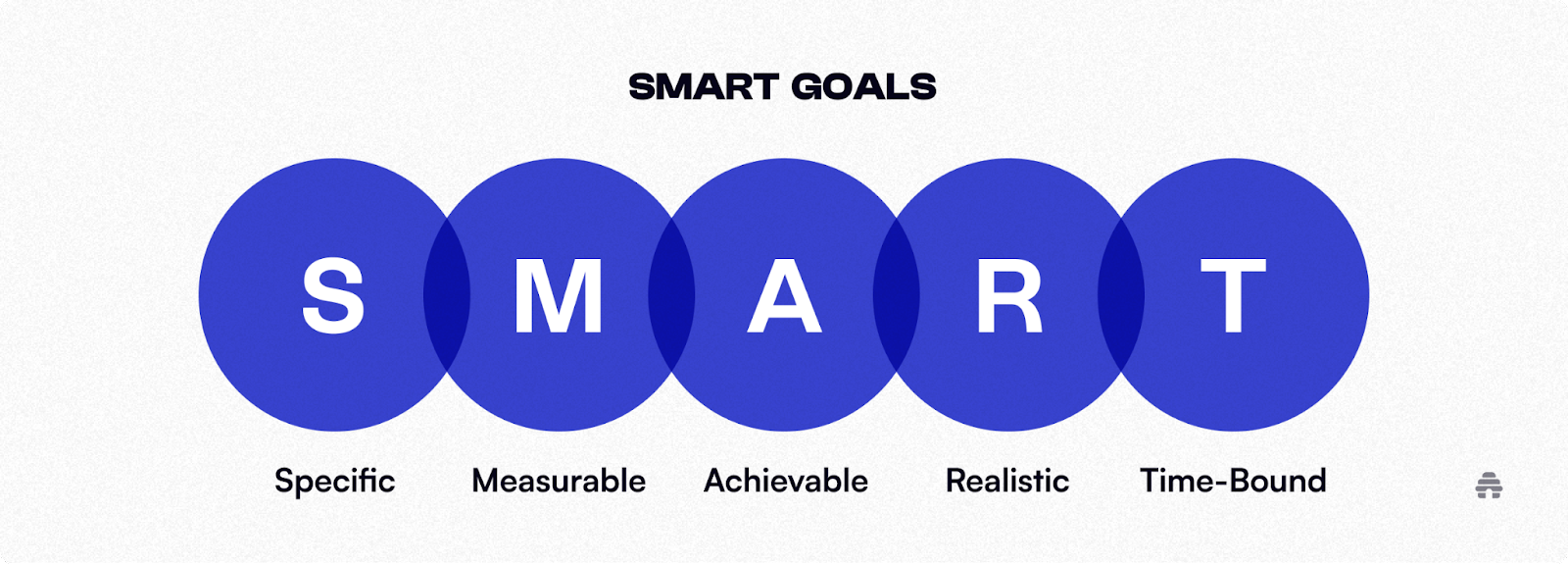
a. Set Specific Goals: Clearly define your marketing objectives, ensuring that they are specific, measurable, achievable, relevant, and time-bound (SMART). Avoid vague goals and focus instead on tangible outcomes that align with your overall business strategy.
-
Develop Comprehensive Marketing Strategies

a. Craft Compelling Content: Create high-quality content that resonates with your target audience, addressing their pain points and providing valuable insights. Utilize various formats like blog posts, infographics, videos, and case studies.
b. Leverage Social Media Engagement: Establish a strong presence on relevant social media platforms, engaging with your audience, sharing industry news, and promoting your brand’s unique value proposition.
c. Harness Email Marketing: Build an email subscriber list and nurture relationships through personalized, informative email campaigns. Showcase your expertise, offer valuable content, and drive traffic to your website or landing pages.
d. Optimize for Search Engines: Implement effective search engine optimization (SEO) techniques to improve your website’s visibility in search results. Utilize relevant keywords, optimize page titles and meta descriptions, and build high-quality backlinks.
e. Explore Paid Advertising: Consider using paid advertising campaigns, such as pay-per-click (PPC) or social media advertising, to reach a wider audience and drive targeted traffic to your website.
-
Create a Detailed Marketing Budget
a. Allocate Resources Wisely: Determine the financial resources you will allocate to your B2B marketing initiatives. Consider the costs of tools, platforms, content creation, and advertising.
b. Prioritize Investments: Prioritize investments in marketing activities that align with your defined goals and target audience. Evaluate the potential return on investment (ROI) for each initiative.
-
Implement Your Marketing Plan With Precision
a. Establish a Timeline: Create a timeline and schedule for implementing your B2B marketing plan. Set realistic deadlines and milestones to ensure timely execution and consistent progress.
b. Assign Clear Roles: Delegate responsibilities to each team member involved in the B2B marketing plan. Ensure effective communication, collaboration, and accountability.
-
Continuously Monitor and Evaluate Progress

a. Track Key Performance Indicators (KPIs): Establish relevant KPIs to track the progress of your marketing efforts and measure their effectiveness. Monitor website traffic, lead generation, conversion rates, and customer engagement metrics.
b. Analyze Results and Adjust: Regularly review your marketing performance data and identify areas for improvement. Make data-driven adjustments to your strategies and tactics as needed.
-
Embrace Continuous Improvement
a. Stay Ahead of Trends: Keep ahead of key trends and developments in your industry that may impact your marketing efforts. Adapt your strategies and tactics to remain relevant and competitive.
b. Refine Customer Personas: Regularly review and refine your customer personas to ensure they accurately reflect evolving customer needs and preferences.
c. Enhance Content Strategy: Continuously evaluate your content strategy and adapt it to meet the changing needs of your target audience.
d. Optimize Marketing Channels: Regularly assess the effectiveness of your marketing channels and reallocate resources accordingly to maximize ROI.
By following these comprehensive steps, you can effectively navigate the ever-evolving B2B marketing landscape and achieve sustainable growth and success.
B2B Marketing Planning Template
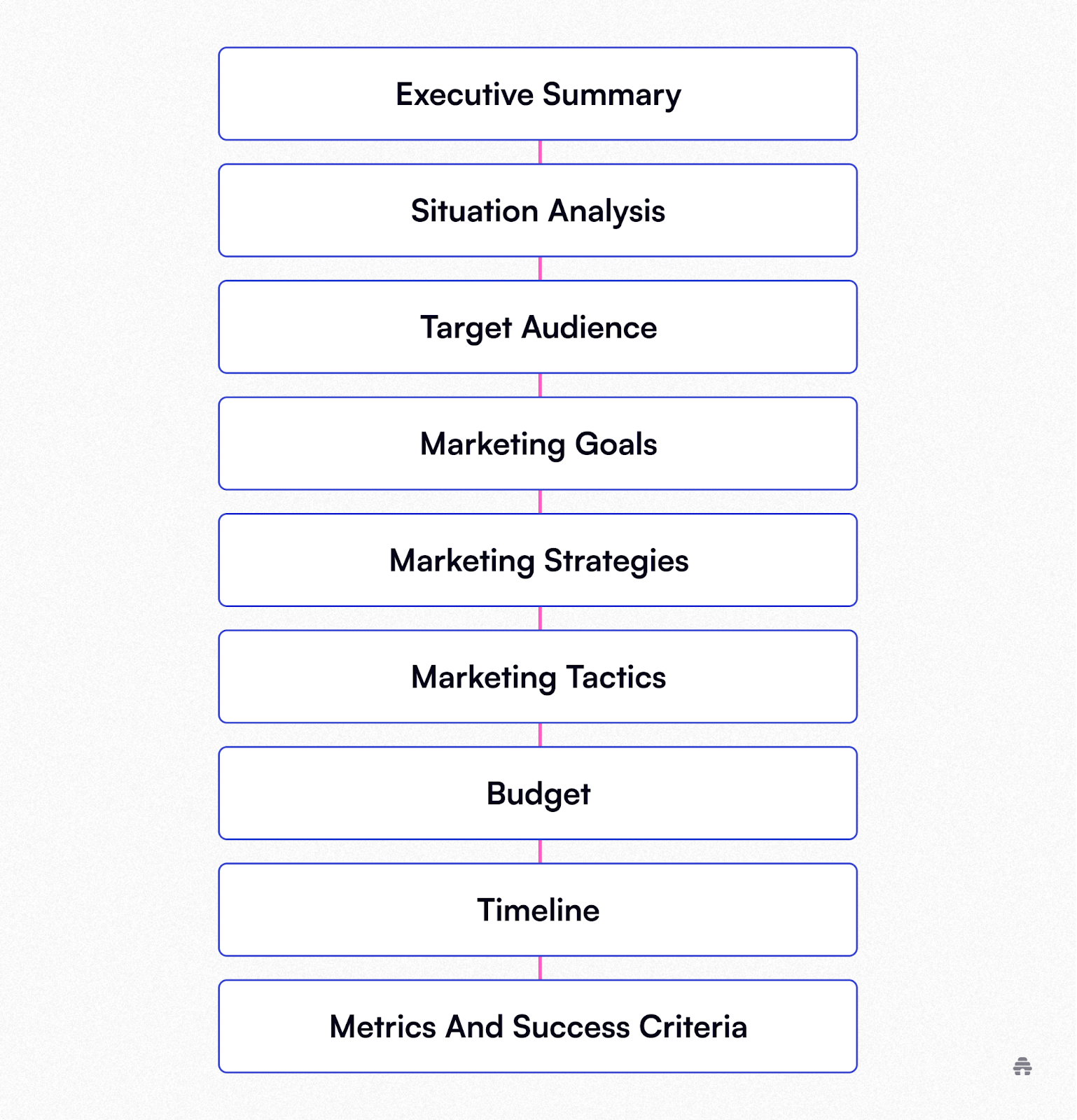
A B2B marketing planning template can help you organize your thoughts and develop a comprehensive marketing plan.
Here are some key components you should include:
-
Executive summary
-
Situation analysis
-
Target audience
-
Marketing goals
-
Marketing strategies
-
Marketing tactics
-
Budget
-
Timeline
-
Metrics and success criteria
How To Use the B2B Marketing Planning Template
Planning your B2B marketing strategy is crucial to the success of your business. A B2B marketing planning template can help you organize your marketing plan into actionable steps.
-
Start by crafting an executive summary that provides a high-level overview of your marketing plan to get started.
-
Conduct a comprehensive situation analysis that includes an assessment of your current market position, strengths, weaknesses, opportunities, and threats.
-
Define your target audience and set marketing goals. By doing so, you can develop effective marketing strategies and tactics to achieve your goals. Determine what makes your target audience unique and tailor your marketing efforts to meet their needs.
-
Create a budget for your B2B marketing plan. Consider the costs of each marketing strategy and tactic and allocate your budget accordingly.
-
Set a realistic timeline for implementation and track your results regularly.
-
Measure your success against predefined metrics and success criteria, so you can make better decisions and improve your marketing efforts.
Following these steps, you can develop a comprehensive plan to help you achieve your marketing goals and grow your business.
Examples of Successful B2B Marketing Plans
A well-crafted B2B marketing plan serves as a roadmap for success, outlining strategies, tactics, and measurable goals that can propel your business to new heights.
While there is no one-size-fits-all approach to B2B marketing planning, successful plans share several common elements.
Common Elements of Successful B2B Marketing Plans
To create a successful B2B marketing plan, businesses must clearly understand their target audience, set specific and measurable goals, and develop comprehensive marketing strategies.
We have compiled a list of essential elements for a successful B2B marketing plan:
-
Target Audience Definition: Clearly define your ideal buyer personas, understanding their demographics, pain points, and decision-making processes.
-
Goal Setting: Establish specific, measurable, achievable, relevant, and time-bound (SMART) goals that align with your overall business objectives.
-
Marketing Strategies: Outline your strategies to reach your target audience and achieve your goals.
-
Tactics and Activities: Develop detailed tactics and activities that support your chosen strategies.
-
Measurement and Evaluation: Establish key performance indicators (KPIs) to track the progress of your marketing efforts and measure their effectiveness.
-
Budget Allocation: Determine the financial resources you will allocate to your B2B marketing initiatives.
-
Timeline and Schedule: Create a timeline and schedule for implementing your B2B marketing plan.
-
Team Responsibilities: Assign clear roles and responsibilities to each team member involved in the B2B marketing plan.
-
Continuous Improvement: Regularly review and update your B2B marketing plan to adapt to changing market conditions, customer needs, and emerging technologies.
Best B2B Marketing Campaigns
The world of B2B marketing is full of innovative, impactful campaigns that have broken the mold and achieved remarkable success. These campaigns showcase the power of creative thinking and strategic planning and serve as inspiring examples for businesses seeking to make their mark.
Whether you’re a seasoned B2B marketer or just starting, these campaigns offer valuable insights and lessons that can help shape your marketing initiatives.
HubSpot’s “Make My Persona” Campaign

HubSpot’s “Make My Persona” campaign was a resounding success, generating over 382,000 leads. The campaign’s interactive and personalized nature resonated with potential customers eager to learn more about buyer personas and how to create their own.
Adobe’s “Click, Baby, Click” Campaign

Adobe’s “Click, Baby, Click” ad campaign was a humorous and effective way to showcase the ease of use of their products. The campaign featured a series of videos that parodied office environments, and it was very successful in generating leads and increasing sales.
B2B Marketing Channels
Choosing the right channels to reach your B2B target audience is challenging.
Adopt a strategic approach by considering audience preferences, business objectives, and budget constraints to ensure that your marketing efforts succeed.
Channel Selection: Aligning Channels With Goals and Audience

The key to effective B2B marketing is aligning your channel selection with your specific business objectives and target audience preferences.
-
Begin by understanding your ideal customer personas and delving into their demographics, pain points, and decision-making processes.
-
Identify the channels where your target audience is most active and engaged, considering their preferred platforms for consuming information and interacting with brands.
-
Evaluate your business goals and the specific outcomes you aim to achieve with your B2B marketing efforts.
Whether generating leads, nurturing relationships, or driving brand awareness, different channels excel in various areas. For instance, email marketing is highly effective for lead nurturing, while social media offers a platform for brand building and audience engagement.
Budget Considerations: Balancing Channel Costs and ROI
As you explore various B2B marketing channels, it’s essential to consider the associated costs and potential return on investment (ROI).
Evaluate the upfront investment required for each channel, including platform fees, content creation costs, and additional advertising expenses.
Weigh these costs against the projected ROI, considering the potential increase in leads, sales, or brand awareness that each channel can generate.
Market Trends and Audience Behavior
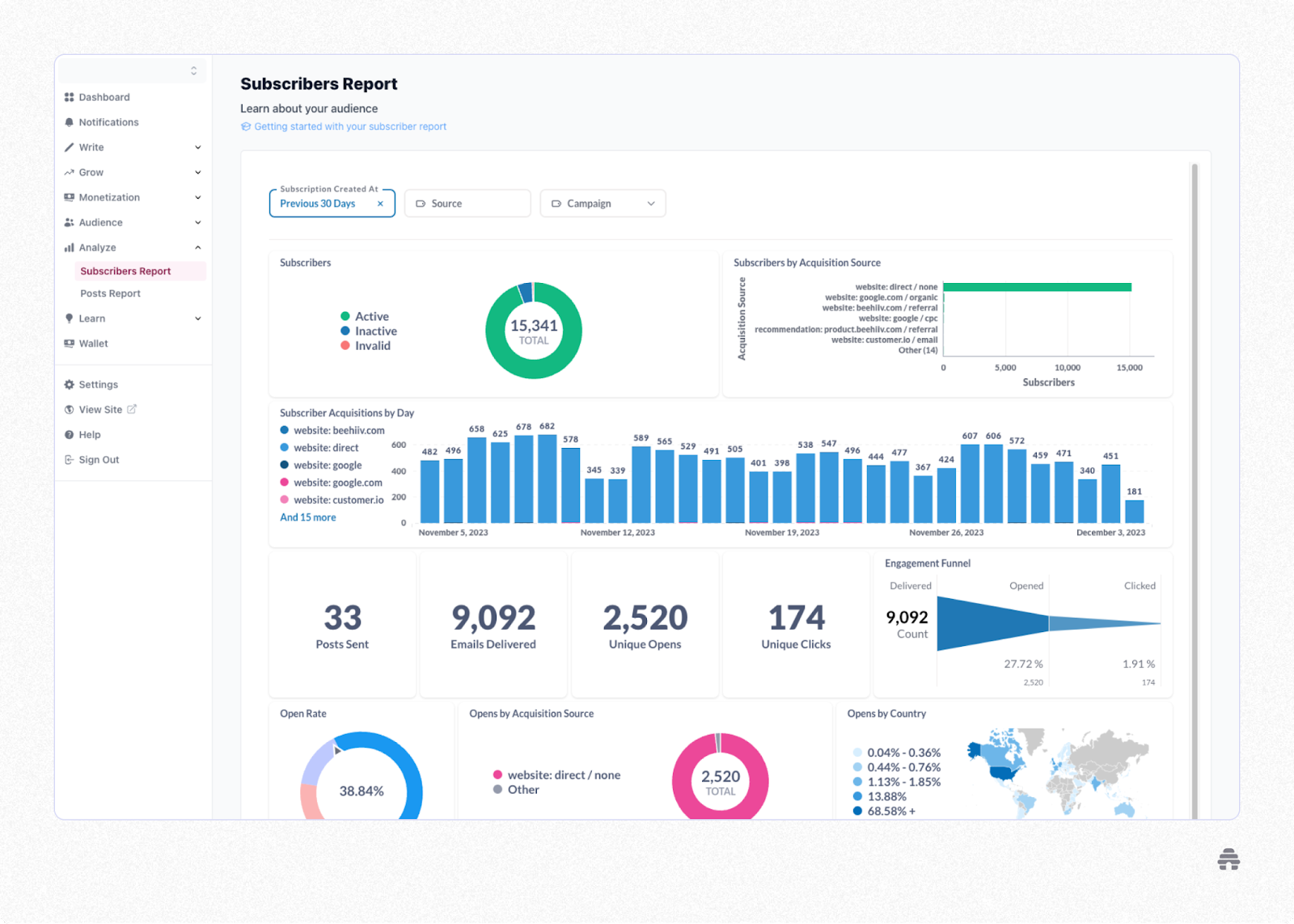
The world of B2B marketing is constantly evolving with new and existing channels. To succeed, it’s essential to be adaptable, continuously evaluate performance, and adjust your strategy as needed.
Keep track of important metrics such as engagement rates, conversion rates, and cost-per-acquisition to gauge the effectiveness of each channel.
Analyze market trends, industry developments, and changing audience preferences to identify new opportunities and refine your channel strategy accordingly.
To effectively navigate the multitude of marketing options, it’s essential to align channels with goals and audiences, consider budget constraints, and continuously evaluate and optimize your strategy.
With a well-defined channel strategy, you can transform your B2B marketing efforts into a powerful driving force for business growth and achieve sustainable success in the ever-evolving B2B marketing landscape.
Types of B2B Marketing Channels
B2B marketing channels serve as the conduits through which you connect with your target audience, convey your brand’s message, and ultimately drive business growth. Each channel offers a distinct avenue for engagement, providing opportunities to nurture relationships, generate leads, and foster brand loyalty.
Traditional B2B Marketing Channels

Traditional B2B marketing channels have been around for decades and have proven effective in reaching a broad audience of business professionals. These channels include:
-
Email Marketing: Email marketing remains a highly effective way to reach your target audience with personalized messages and content.
-
Industry Events and Conferences: Industry events and conferences provide opportunities to network with potential customers, showcase your products or services, and learn about industry trends.
-
Direct Mail: Direct mail can effectively reach your target audience with targeted messages and promotions.
-
Telemarketing: Telemarketing can generate leads, qualify prospects, and upsell existing customers.
-
Print Advertising: Print advertising can reach a broad audience of business professionals in industry-specific publications.
Digital B2B Marketing Channels
Digital B2B marketing channels have emerged in recent years and offer a variety of ways to reach your target audience online. These channels include:

-
Search Engine Optimization (SEO): SEO helps your website rank higher in search engine results, making it easier for potential customers to find you.
-
Pay-Per-Click (PPC) Advertising: PPC advertising allows you to pay for your ads to appear at the top of search engine results or on websites relevant to your target audience.
-
Content Marketing: Content marketing involves creating and sharing valuable content relevant to your target audience. This can include blog posts, infographics, videos, and white papers.
-
Social Media Marketing: Social media marketing allows you to connect with your target audience on social media platforms like LinkedIn, Twitter, and Facebook.
-
Email Marketing Automation: Email marketing automation allows you to send personalized emails to your target audience based on their interests and behavior.
-
Influencer Marketing: Influencer marketing involves partnering with influencers in your industry to promote your products or services.
Why Trust Us
Linda Hwang has extensive experience in B2B marketing and previously worked at a renowned international facilities management company. During her time there, she played a crucial role in creating effective marketing plans for content and social media. Now, Linda is a marketing consultant, helping small businesses create compelling brand stories.
Choosing the Right B2B Marketing Channels
Your business’s best B2B marketing channels depend on your target audience, business objectives, and budget. Experimenting with different channels is essential to see what works best for you.
Here are some factors to consider when choosing B2B marketing channels:
-
Target audience: Which channels do your target audience use most often?
-
Business objectives: What do you want to achieve with your marketing efforts?
-
Budget: How much can you afford to spend on marketing?
-
Resources: Do you have the resources to create and manage content for each channel?
By selecting the proper B2B marketing channels and using them effectively, you can reach your target audience, generate leads, and drive business growth.
What Is the B2B Marketing Mix?
In business-to-business (B2B) marketing, achieving sustainable success hinges on a well-defined and effective marketing strategy.
That’s where the B2B marketing-mix comes in!
The B2B marketing mix, known as the 7Ps, is a comprehensive framework for developing and executing successful marketing campaigns tailored specifically to the B2B landscape.
This strategic framework encompasses seven key elements: product, price, place, promotion, people, process, and physical evidence.

Understanding the intricacies of the B2B marketing mix is crucial for businesses seeking to establish a strong brand identity, cultivate lasting customer relationships, and ultimately drive business growth.
By meticulously crafting a B2B marketing mix that aligns with specific business objectives and target audience preferences, B2B marketers can effectively navigate the complexities of the B2B marketplace and achieve tangible results.
Components of the B2B Marketing Mix

The B2B marketing mix comprises seven critical components: product, price, place, promotion, people, process, and physical evidence.
-
Product: The Core Offering
The product, the heart of the B2B marketing mix, represents the tangible or intangible good or service offered to the target audience. It encompasses the product’s features, benefits, and unique value proposition that addresses the specific needs and pain points of B2B customers.
Example: A software company offering a cloud-based CRM system highlights its features, such as improved customer segmentation, streamlined sales processes, and enhanced customer insights.
Price plays a pivotal role in B2B marketing, as it determines the perceived value of the product or service. It should be carefully considered to balance profitability with customer affordability and align with industry pricing norms.
Example: A consulting firm offering strategic marketing services might consider a value-based pricing approach, charging based on the projected ROI generated for the client.
-
Place: Ensuring Accessibility
Place, or distribution, refers to the channels and methods through which the product or service reaches the target audience. It encompasses both physical and digital distribution strategies.
Example: A manufacturing company might utilize a combination of direct sales to large-scale clients, partnerships with distributors for broader reach, and e-commerce platforms for online sales.
-
Promotion: Communicating Value
Promotion encompasses the various communication channels and strategies to inform, persuade, and engage the target audience about the product or service. It includes advertising, public relations, content marketing, and social media engagement.
Example: A technology company might launch a targeted online advertising campaign showcasing the innovative features of their latest product, coupled with a social media influencer marketing strategy.
People, often overlooked, represent the human element of the B2B marketing mix. It emphasizes the importance of skilled and knowledgeable salespeople, customer service representatives, and industry experts in fostering strong customer relationships and building brand loyalty.
Example: A healthcare company might provide comprehensive training to its sales team, enabling them to effectively understand and address the specific needs of medical professionals and healthcare organizations.
-
Process: Streamlining Customer Experience
Process refers to the systematic procedures and workflows that govern the customer journey, from initial inquiry to post-sales support. It encompasses order processing, delivery, customer service interactions, and feedback mechanisms.
Example: An e-learning platform might implement an automated customer onboarding process, providing new users with personalized tutorials, guided tours, and access to relevant support resources
-
Physical Evidence: Tangible Representation
Physical evidence, often associated with tangible goods, represents the visual and tactile cues that reinforce the brand’s presence and the quality of the product or service. It includes packaging, brochures, and company headquarters.
Example: A luxury fashion brand might invest in high-quality packaging materials, personalized messages, and exclusive product launches to convey a sense of premium value and exclusivity.
The B2B marketing mix is a roadmap for success in the ever-evolving B2B landscape. By meticulously crafting a marketing strategy that aligns with each element of the 7Ps, B2B marketers can effectively reach their target audience, generate leads, nurture customer relationships, and drive sustainable business growth.
The 4C’s of B2B Marketing

The 4Cs of B2B marketing is a framework that shifts the traditional focus from what a company wants to sell to what a customer wants to buy.
This customer-centric model includes Customer Solutions, Cost, Convenience, and Communication.
-
Customer Solution: Rather than focusing on the product or service, this element emphasizes solving the customer’s problem. Businesses must understand their customers’ needs and develop solutions to them.
For example, IBM doesn’t sell just computers; they sell keys for data management, cybersecurity, and more based on their clients’ needs.
-
Customer Cost: This refers not only to the price of the product or service but also to the total cost of ownership, including costs associated with implementation, operation, maintenance, and disposal.
For instance, a software solution might have a reasonable upfront cost. Still, if it requires substantial training, frequent updates, and expensive support, the total cost to the customer could be high.
-
Convenience: Instead of focusing on where the product or service is sold, the emphasis here is on making the purchase process as easy and convenient as possible for the customer. This can involve digital sales platforms, streamlined purchasing processes, or personalized customer service.
Amazon Business, for example, offers a familiar and convenient shopping experience tailored to the needs of businesses.
-
Communication: This replaces Promotion in the 4Ps, shifting the focus from persuading customers to buy to engaging in two-way communication with them. This can involve social media engagement, content marketing, webinars, and other strategies to create dialogue and build customer relationships.
beehiiv, for instance, leverages its blog and social media channels to engage with customers, provide valuable information, and build long-term relationships.
The 4Cs of B2B marketing emphasize the need to focus on the customer’s perspective, understand their needs, and provide solutions conveniently and communicatively.
B2B Marketing Trends for 2024
As we continue through 2024, the B2B marketing landscape is poised to undergo a series of transformative shifts driven by technological advancements, evolving customer expectations, and the ever-increasing importance of data-driven decision-making.
To thrive in this dynamic environment, B2B marketers must embrace these emerging trends and adapt their strategies accordingly.
Here are a few B2B marketing trends for 2024:
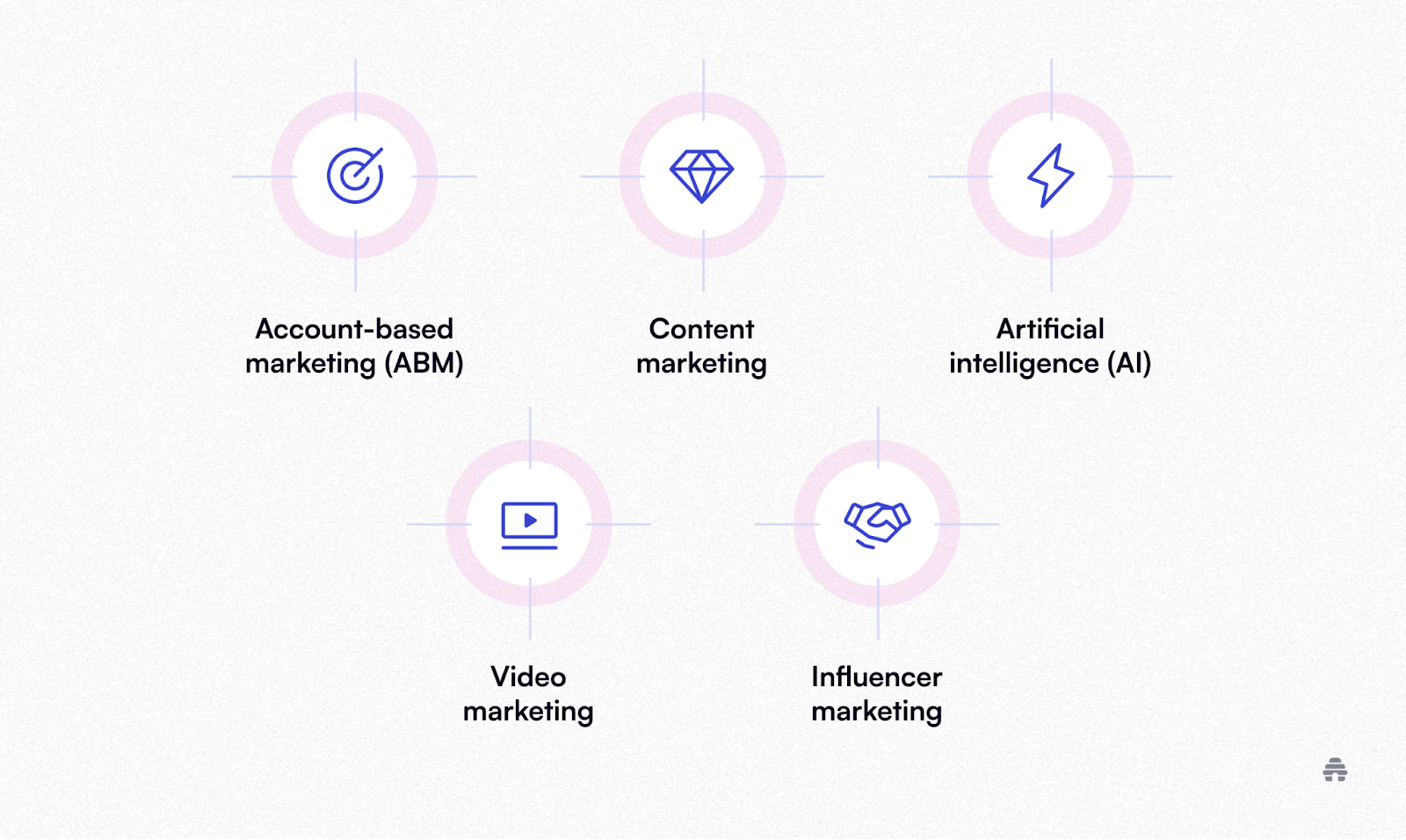
-
Account-based marketing (ABM): A targeted marketing approach that focuses on specific accounts
-
Content marketing: Creating and distributing valuable content to attract and engage target customers
-
Artificial intelligence (AI): Using AI to improve marketing activities, such as targeting and personalization
-
Video marketing: Using video to connect with and engage target customers
-
Influencer marketing: Partnering with influencers to promote your products or services
Predicted B2B Marketing Trends for 2024
In the continually changing world of B2B marketing, keeping up with the latest trends is crucial to success.
In 2024, the B2B marketing industry is set to experience significant changes due to technological advancements, evolving customer demands, and the growing importance of data-driven decision-making.
-
Personalization at Scale: Tailoring Experiences for Individual Customers
Personalization, no longer a buzzword but a necessity, will continue to dominate B2B marketing in 2024.
Businesses will increasingly leverage data analytics and artificial intelligence (AI) to gain deeper insights into their target audience, enabling them to deliver personalized experiences that resonate with individual customers.
-
Video Marketing Dominance: Capturing Attention in a Visually Driven World
Video marketing is poised to become even more prevalent in the B2B landscape in 2024. Businesses will recognize the power of video to capture attention, convey complex messages, and build brand engagement.
From explainer videos to customer testimonials, video will become integral to B2B marketing strategies.
-
Integration of AI and Automation: Embracing Intelligent Marketing
Businesses will adopt AI-powered tools to automate repetitive tasks, streamline workflows, and gain actionable insights from data. This will allow marketers to focus on strategic initiatives like content creation and customer relationship management.
-
Focus on Sustainability and Ethics: Aligning Marketing Practices With Values
Sustainability and ethics will become increasingly important considerations for B2B marketers in 2024.
Businesses will align their marketing practices with their commitments to environmental and social responsibility, ensuring that their campaigns are effective, ethical, and sustainable.
-
Voice Search Optimization: Adapting to a Conversational World
Voice search is rapidly gaining popularity, and B2B marketers must adapt their strategies accordingly.
Optimizing content for voice search will involve using natural language and long-tail keywords, ensuring that websites and landing pages are mobile-friendly and creating voice-activated experiences.
B2B Marketing Strategies
The cornerstone of any successful marketing venture lies in strategy. In the realm of B2B marketing, this is particularly crucial.
B2B marketing strategies are the blueprint that guides your business toward its goals. They provide a clear path to effectively reach and engage with other companies, fostering relationships and driving growth.
But what makes a good B2B marketing strategy? How can you ensure that your strategy aligns with your business objectives and resonates with your target audience?
Let’s delve into B2B marketing planning and explore the elements that shape successful strategies.
Innovative B2B Marketing Strategies
Businesses are constantly seeking fresh, unique ways to stand out from the crowd and capture the attention of their target audience.
This is where innovative B2B marketing strategies come into play.
These strategies push the boundaries of traditional marketing, incorporating new technologies, platforms, and methodologies to deliver impactful results. This section will examine some of the most innovative B2B marketing strategies, highlighting how they have revolutionized B2B marketing planning and execution.
Here are a few key examples:
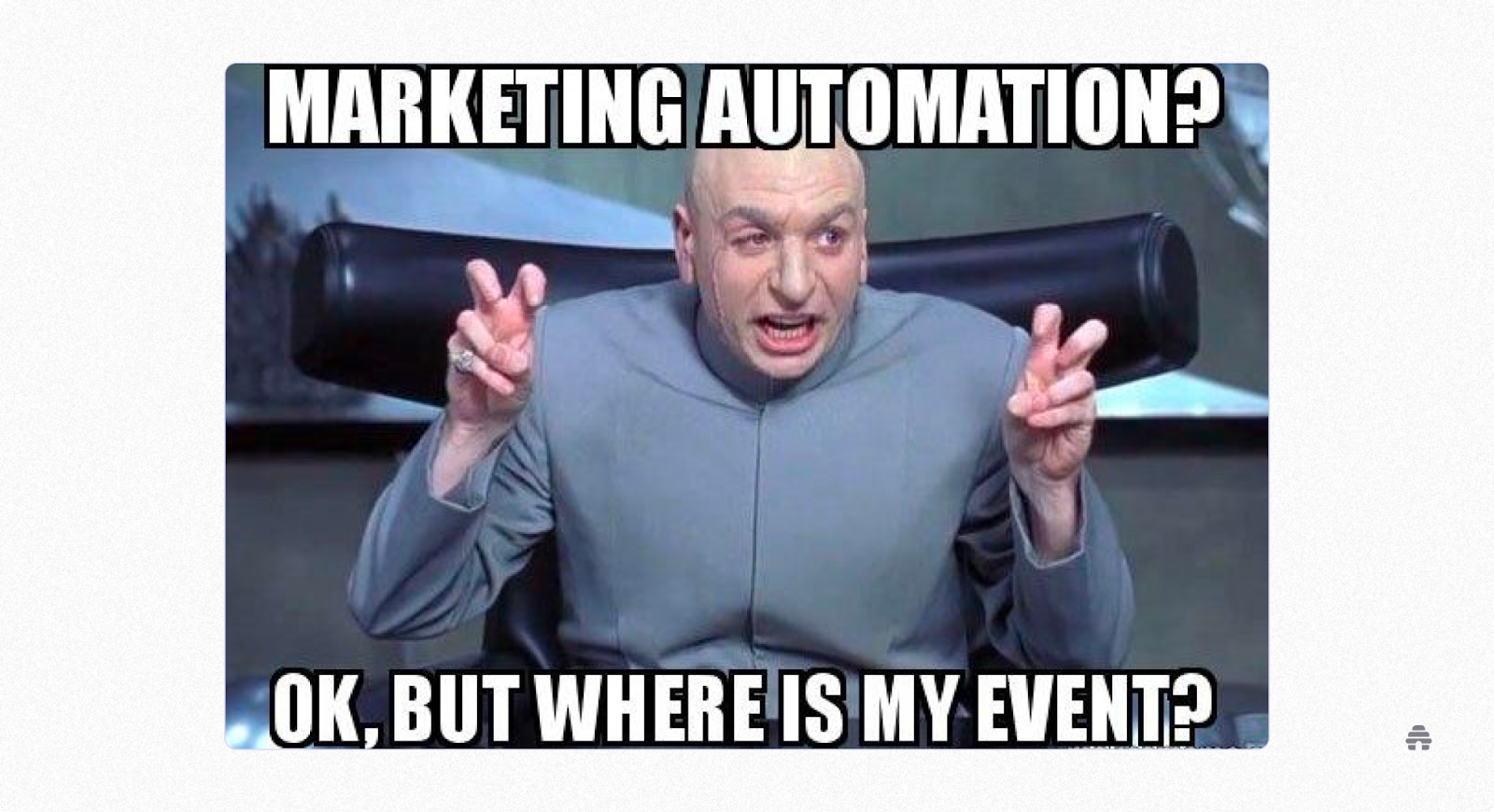
-
Account-Based Marketing (ABM): ABM is a strategy that focuses on targeting specific high-value accounts rather than a broad market. This personalized approach allows companies to concentrate their resources on potential clients most likely to convert.
For instance, LinkedIn successfully utilizes ABM by providing account-targeting solutions, enabling businesses to effectively reach decision-makers within their targeted accounts.
-
Artificial Intelligence (AI) and Machine Learning: These technologies are being leveraged to analyze customer data and predict future behavior, enhancing personalization and relevance in marketing efforts.
Marketo, a leading marketing automation platform, uses AI to provide predictive content, recommending the best content to engage everyone based on their past behaviors and preferences.
-
Content Marketing: This strategy involves creating and sharing valuable content to attract and retain a clearly defined audience.
Adobe’s CMO.com is an excellent example of effective content marketing. The site delivers digital marketing insights, expertise, and inspiration for and by marketing leaders—all aimed at helping CMOs and senior marketers lead their brands in this new digital world.
Microsoft, for example, has a dedicated LinkedIn page for its Office product, sharing updates, tips, and use cases to engage with its business customers.
-
Webinars and Virtual Events: These have become powerful tools for B2B marketers, especially in the wake of the pandemic. They offer an interactive way to engage with prospects and clients while delivering valuable content.
HubSpot, for instance, regularly hosts webinars covering various topics related to inbound marketing, sales, and customer service.
These innovative strategies have transformed traditional B2B marketing planning and execution, shifting the focus towards more personalized, engaging, and data-driven methods.
B2B Marketing Courses
Knowledge is power. As the world of B2B marketing continues to evolve and expand, staying up-to-date with the latest trends and techniques is essential.
One effective way to do this is through B2B marketing courses.
These courses offer valuable insights and practical knowledge, equipping you with the tools needed to navigate the complex landscape of B2B marketing planning.
Whether you’re a seasoned professional looking to refresh your skills or a newcomer wanting to learn the ropes, B2B marketing courses can be a valuable investment.
Best B2B Marketing Courses
Not all B2B marketing courses are created equal. Some offer in-depth, comprehensive content, expert instructors, and practical learning experiences.
From beginner to advanced levels, these courses offer something for everyone looking to excel in B2B marketing.
-
LinkedIn B2B Marketing Foundations:

This course offers bite-sized lessons covering various topics, from writing a B2B marketing plan to developing a pricing strategy.
The course is highly rated for its comprehensive, yet easily digestible content, making it an excellent choice for beginners and experienced marketers.
It’s available as part of LinkedIn Learning’s subscription, which costs $29.99/month after a one-month free trial (source).
-
International B2B Marketing on Coursera:

This course provides a unique perspective into the differentiating aspects of B2B marketing contrasted with traditional consumer marketing. It’s praised for its in-depth content and practical approach.
The course cost varies depending on whether you want to earn a certificate or audit the course for free. A certificate typically costs around $49/month (source).
B2B Marketing Strategy Framework
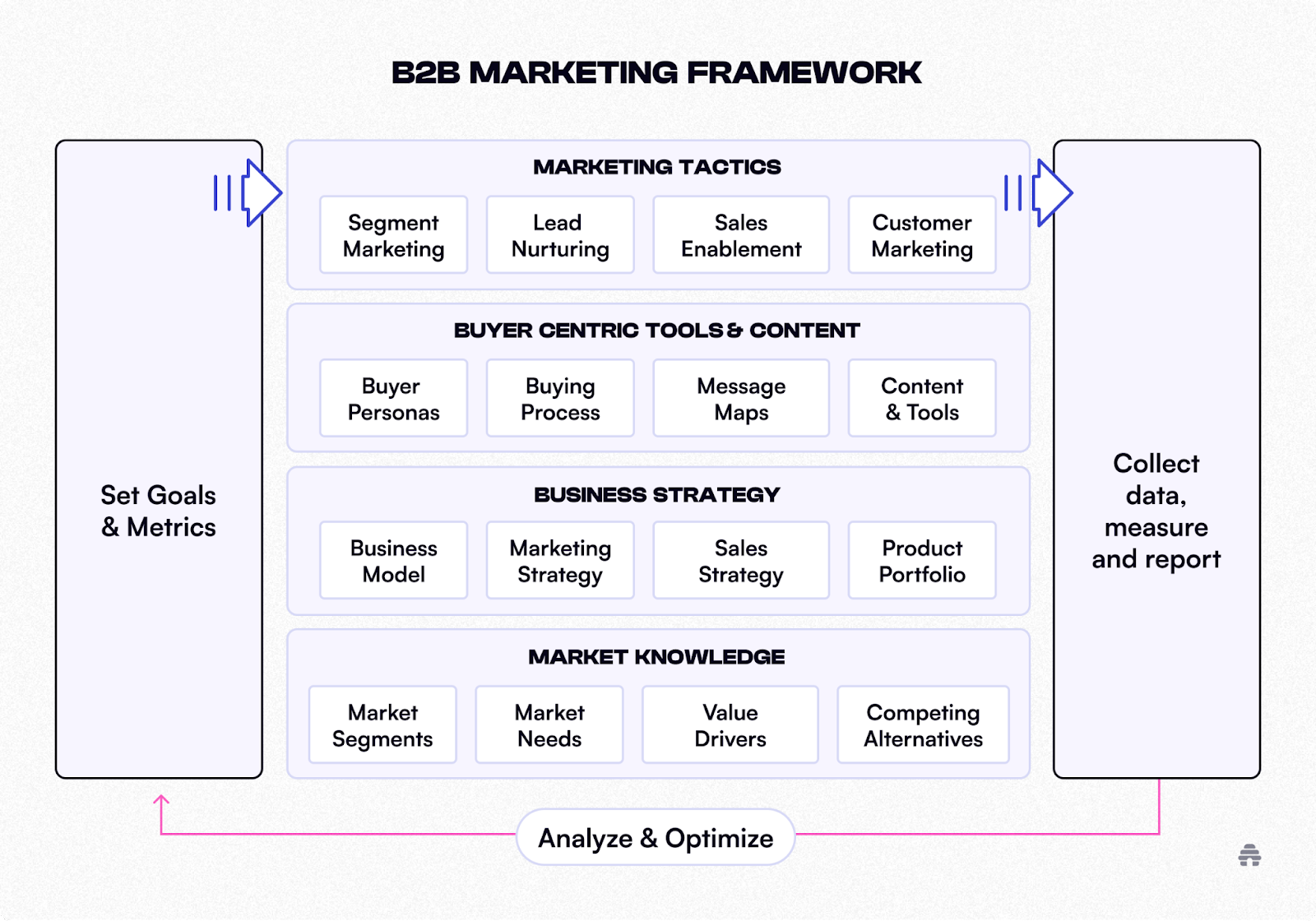
A B2B marketing strategy framework serves as a roadmap for success, outlining the steps, tactics, and metrics to guide your efforts toward achieving specific business objectives and fostering lasting customer relationships.
Crafting a winning B2B marketing strategy starts with the framework. Here are the critical elements of your B2B marketing strategy:
-
Define Your Target Audience: Identify your ideal customer personas, understanding their demographics, pain points, and decision-making processes.
-
Set SMART Goals: Establish specific, measurable, achievable, relevant, and time-bound (SMART) goals that align with your overall business objectives.
-
Develop Comprehensive Marketing Strategies: Outline your strategies to reach your target audience and achieve your goals.
-
Create Detailed Tactics and Activities: Develop specific tactics and activities that support your chosen strategies.
-
Establish Key Performance Indicators (KPIs): Determine the metrics you will track to measure the effectiveness of your marketing efforts.
-
Allocate a Realistic Budget: Determine the financial resources you will allocate to your B2B marketing initiatives.
-
Create a Timeline and Schedule: Establish a timeline and schedule for implementing your B2B marketing plan.
-
Assign Clear Roles and Responsibilities: Assign clear roles and responsibilities to each team member involved in the B2B marketing plan.
-
Continuous Evaluation and Improvement: Regularly review and update your B2B marketing plan to adapt to changing market conditions, customer needs, and emerging technologies.
Benefits of Implementing a B2B Marketing Strategy Framework
Below, we have listed some critical benefits of implementing a B2B marketing planning strategy framework:
-
Enhanced Focus and Clarity: A well-defined framework provides direction and focus, ensuring that marketing efforts are aligned with overall business goals.
-
Improved Efficiency and Productivity: A structured framework streamlines processes and eliminates wasted efforts, maximizing resource utilization.
-
Data-Driven Decision-Making: Marketers can make informed decisions based on data rather than guesswork by establishing KPIs and tracking performance.
-
Adaptability and Agility: A flexible framework allows for adjustments to strategies and tactics as market conditions or customer needs evolve.
-
Increased Accountability and Ownership: Defined roles and responsibilities foster accountability and ownership among team members.
How To Use the B2B Marketing Strategy Framework
Crafting a well-defined strategy framework is not merely an option but necessary for achieving sustainable growth and success.
By outlining clear objectives, tactics, and metrics, businesses can effectively navigate the complexities of the B2B marketplace, foster strong customer relationships, and drive measurable results.
Final Thoughts on B2B Marketing Planning
As you craft a B2B marketing plan, remember that it is not a mere checklist to be ticked off but a dynamic roadmap that will guide your efforts toward achieving sustainable success.
Embrace the power of data-driven decision-making, prioritize customer-centricity, and continuously adapt your strategies to the ever-evolving B2B landscape.
💌 Ready to take your newsletter game to the next level? beehiiv is the platform for you! With features designed for growth and monetization, we’re here to empower creators like you.
Join a community of over 7,500 active users who are already leveraging the power of beehiiv to scale their newsletter like never before. Whether you’re just starting or an established newsletter publisher, beehiiv offers the tools you need to succeed.
SOCIAL
Snapchat Explores New Messaging Retention Feature: A Game-Changer or Risky Move?

In a recent announcement, Snapchat revealed a groundbreaking update that challenges its traditional design ethos. The platform is experimenting with an option that allows users to defy the 24-hour auto-delete rule, a feature synonymous with Snapchat’s ephemeral messaging model.
The proposed change aims to introduce a “Never delete” option in messaging retention settings, aligning Snapchat more closely with conventional messaging apps. While this move may blur Snapchat’s distinctive selling point, Snap appears convinced of its necessity.
According to Snap, the decision stems from user feedback and a commitment to innovation based on user needs. The company aims to provide greater flexibility and control over conversations, catering to the preferences of its community.
Currently undergoing trials in select markets, the new feature empowers users to adjust retention settings on a conversation-by-conversation basis. Flexibility remains paramount, with participants able to modify settings within chats and receive in-chat notifications to ensure transparency.
Snapchat underscores that the default auto-delete feature will persist, reinforcing its design philosophy centered on ephemerality. However, with the app gaining traction as a primary messaging platform, the option offers users a means to preserve longer chat histories.
The update marks a pivotal moment for Snapchat, renowned for its disappearing message premise, especially popular among younger demographics. Retaining this focus has been pivotal to Snapchat’s identity, but the shift suggests a broader strategy aimed at diversifying its user base.
This strategy may appeal particularly to older demographics, potentially extending Snapchat’s relevance as users age. By emulating features of conventional messaging platforms, Snapchat seeks to enhance its appeal and broaden its reach.
Yet, the introduction of message retention poses questions about Snapchat’s uniqueness. While addressing user demands, the risk of diluting Snapchat’s distinctiveness looms large.
As Snapchat ventures into uncharted territory, the outcome of this experiment remains uncertain. Will message retention propel Snapchat to new heights, or will it compromise the platform’s uniqueness?
Only time will tell.
SOCIAL
Catering to specific audience boosts your business, says accountant turned coach

While it is tempting to try to appeal to a broad audience, the founder of alcohol-free coaching service Just the Tonic, Sandra Parker, believes the best thing you can do for your business is focus on your niche. Here’s how she did just that.
When running a business, reaching out to as many clients as possible can be tempting. But it also risks making your marketing “too generic,” warns Sandra Parker, the founder of Just The Tonic Coaching.
“From the very start of my business, I knew exactly who I could help and who I couldn’t,” Parker told My Biggest Lessons.
Parker struggled with alcohol dependence as a young professional. Today, her business targets high-achieving individuals who face challenges similar to those she had early in her career.
“I understand their frustrations, I understand their fears, and I understand their coping mechanisms and the stories they’re telling themselves,” Parker said. “Because of that, I’m able to market very effectively, to speak in a language that they understand, and am able to reach them.”Â
“I believe that it’s really important that you know exactly who your customer or your client is, and you target them, and you resist the temptation to make your marketing too generic to try and reach everyone,” she explained.
“If you speak specifically to your target clients, you will reach them, and I believe that’s the way that you’re going to be more successful.
Watch the video for more of Sandra Parker’s biggest lessons.
SOCIAL
Instagram Tests Live-Stream Games to Enhance Engagement

Instagram’s testing out some new options to help spice up your live-streams in the app, with some live broadcasters now able to select a game that they can play with viewers in-stream.
As you can see in these example screens, posted by Ahmed Ghanem, some creators now have the option to play either “This or That”, a question and answer prompt that you can share with your viewers, or “Trivia”, to generate more engagement within your IG live-streams.
That could be a simple way to spark more conversation and interaction, which could then lead into further engagement opportunities from your live audience.
Meta’s been exploring more ways to make live-streaming a bigger consideration for IG creators, with a view to live-streams potentially catching on with more users.
That includes the gradual expansion of its “Stars” live-stream donation program, giving more creators in more regions a means to accept donations from live-stream viewers, while back in December, Instagram also added some new options to make it easier to go live using third-party tools via desktop PCs.
Live streaming has been a major shift in China, where shopping live-streams, in particular, have led to massive opportunities for streaming platforms. They haven’t caught on in the same way in Western regions, but as TikTok and YouTube look to push live-stream adoption, there is still a chance that they will become a much bigger element in future.
Which is why IG is also trying to stay in touch, and add more ways for its creators to engage via streams. Live-stream games is another element within this, which could make this a better community-building, and potentially sales-driving option.
We’ve asked Instagram for more information on this test, and we’ll update this post if/when we hear back.
-

 WORDPRESS6 days ago
WORDPRESS6 days ago9 Best WooCommerce Multi Vendor Plugins (Compared)
-

 SEO6 days ago
SEO6 days agoGoogle March 2024 Core Update Officially Completed A Week Ago
-

 MARKETING5 days ago
MARKETING5 days agoNavigating the Video Marketing Maze: Short-Form vs. Long-Form
-

 SEO7 days ago
SEO7 days agoGoogle Declares It The “Gemini Era” As Revenue Grows 15%
-

 SEARCHENGINES6 days ago
SEARCHENGINES6 days agoGoogle March 2024 Core Update Finished April 19, 2024
-
SEARCHENGINES7 days ago
Daily Search Forum Recap: April 25, 2024
-
![The Current State of Google’s Search Generative Experience [What It Means for SEO in 2024] person typing on laptop with](https://articles.entireweb.com/wp-content/uploads/2024/04/The-Current-State-of-Googles-Search-Generative-Experience-What-It.webp-400x240.webp)
![The Current State of Google’s Search Generative Experience [What It Means for SEO in 2024] person typing on laptop with](https://articles.entireweb.com/wp-content/uploads/2024/04/The-Current-State-of-Googles-Search-Generative-Experience-What-It.webp-80x80.webp) MARKETING6 days ago
MARKETING6 days agoThe Current State of Google’s Search Generative Experience [What It Means for SEO in 2024]
-
SEARCHENGINES5 days ago
Daily Search Forum Recap: April 26, 2024














